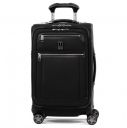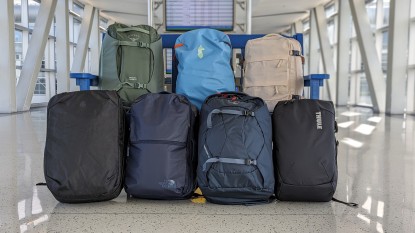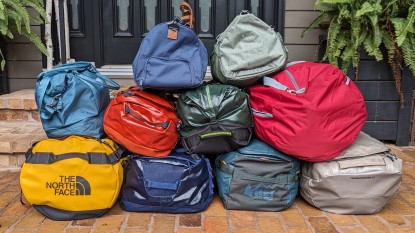A sturdy carry-on bag is an essential purchase for many of us looking for the best carry-on luggage. Whether we're traveling twice a month or twice a year, you always need something to carry your clothes in. And with more airlines charging for checked bags than ever before, bringing your bag on the plane with you is often a good way to save a few extra dollars. In this article, we'll dive into the pros and cons of the various carry-on types and how they may or may not make traveling easier. We'll also outline how and when important factors like internal capacity, durability, and style should play into your decision.
Whether you're new to traveling or looking to become a more efficient traveler, we've got decades worth of travel experience we're happy to share with you. Check out our How to Pack Luggage Like a Pro and Packing List articles for more tips.
Maximum Allowable Bag Size
First and foremost, what constitutes a carry-on? There are typically two requirements when it comes to the size of the bag that you can stow in an overhead bin. First, there are the dimensions of the bag (height, length, and width) and then the overall linear dimension (what you get when you add up the height + length + width). Most airlines have a maximum limit of 22 x 14 x 9 inches, which adds up to a total of 45 linear inches.
Note that airline carriers will include the wheels and handles when measuring a bag, and most have some sort of measuring slot. If you're asked to test your bag, and it doesn't fit in the slot, you'll have to check it. It's a frustrating and often expensive experience. While each of the bags that we tested fit in many different planes' overhead bins, not all fit easily into the measuring slots.
Keep in mind that international carriers have different restrictions, and typically require the bag to be only 20 or 21 inches in height, though they can be wider than the 14 inches required here. Many manufacturers will make “international” sized versions of their popular models for people who travel internationally that have all the same features but are a slightly different size.
In addition to size restrictions, airlines may have a weight limit for carry-on luggage as well, typically 20 to 40 pounds. This is generally not too much of an issue for several reasons. It's hard to fit more than 40 pounds worth of clothing in the smaller dimensions of a carry-on (unless you are packing gold bars, in which case you are probably not flying commercial!) and we have yet to see a scale by the entrance to a plane with a gate agent requesting you weigh your bag. It's more about being able to lift the thing over your head and into/out of a bin in cramped quarters. If you can do that, you're good to go.
Types of Carry-Ons
Many of us are euphoric when we travel lighter and avoid the costs, lines, and hassles of checked bags at airports. There are many choices of carry-on bags and personal items (or one or the other) that can help you skip the lines and head straight through security. Making the right choice will help create a more enjoyable travel experience.
Convertible Carry-Ons
In previous versions of this review, we tested several pieces that converted from rolling carry-on luggage into backpacks. After testing out these bags side-by-side with traditional carry-on luggage, we're not sure how useful it is to be able to convert a rolling bag into a backpack. Convertible luggage is cool and techy, but when you think about the space you give up for backpack straps on a rolling bag or the weight that wheels add onto a backpack, there's a part of us that thinks it's better to choose one or the other and not waffle in between.
We tried to think through a variety of different scenarios where convertible carry-on luggage would be essential. It would be useful if you are more of an adventure traveler and want to be able to take your bag off-road and still be able to roll it once you're in the airport, but if you're an adventure traveler, you're probably more likely to have a travel pack or a backpacking backpack. Convertible luggage might also be useful if you are using multiple travel mediums in one day: walking from your house to the bus (rolling), bus to train (backpack), train to plane (rolling), plane to… boat? (backpack). But even then, some of the convertible backpack designs are more difficult to undo and use on the fly, and we think it's just easier to have one or the other.
Wheeled Carry-Ons
Now that you know you're in the right place and a wheeled bag is the best fit for your travel style, you can examine the many options available. As we work our way through this process, keep in mind your personal travel style, including your packing habits (and amounts), conditions at your intended destination(s), and your personal style preference (professional? globe trotter?).
Two vs. Four Wheels
There are a number of wheel configurations available. Whereas a decade ago you would have been hard-pressed to find a quality four-wheeled spinner bag, today some manufacturers don't make anything but.
After using both four- and two-wheeled luggage side-by-side extensively, we've developed a comprehensive pros and cons list of four-wheeled bags:
Pros of Four-Wheeled Bags- Easier on your arms and shoulders — bag pushes along next to you
- Heavy and large bags can even be pushed by children
- Easier to use when traveling with multiple pieces of luggage (two bags can be pushed with one hand at the same time) or when traveling with children and a stroller
- More maneuverable in airports and planes
Cons of Four-Wheeled Bags
- Protruding wheels more likely to break or get damaged
- The bag can roll away on its own on the uneven ground, such as trains, buses, or sidewalks, if not laid down on its side or secured
- Less internal packing space
- Wheels are typically smaller and less suited to uneven terrain
Overall, we recommend four-wheeled bags for individuals who are traveling from city-to-city and will be using their bag primarily on “polished” surfaces. We'd also recommend them for any frequent flyer experiencing neck or shoulder pain in their pulling arm, or those who routinely fly with heavy bags. Finally, if you only ever bring your bag on the plane with you, the protruding wheels are less likely to get damaged, but if you do check your carry-on luggage frequently, then two-wheeled bags are probably the way to go.
Clamshell vs. Top Flip
Rollaboard bags typically open in one of two ways. Either the front flips open to reveal one large main compartment, or the whole thing splits in half like a clamshell. Both types have their advantages and disadvantages. Top flip systems are typically easier to stay organized since you don't have to flip one half of the luggage upside down onto the other before closing it. They are also more versatile in terms of what sizes and shapes of things they can hold. If you're traveling with bulky sweaters, winter gear, or even just wear large shoes, it can be challenging to easily fit those into a half shell design.
On the other hand, if you like to keep things very separate, the clamshell style might work best for you. There's typically a barrier between the two sides that can be useful if you want to dedicate one side to dirty clothes, for example. It can also be easier to locate what you need without having to rifle through the whole thing, as each half contains less stuff to look through. In general, a top flip design gives more freedom and flexibility to a wider range of packing styles, while the half shell style requires more thought and better “Tetrising” skills.
Hard-Sided vs. Soft-Sided
During our testing process, we learned that there are several pros and cons associated with each type of bag. Hard-sided bags generally protect fragile items better than soft-sided bags (especially soft-sided bags without structured walls). However, hard-sided bags can easily be scratched and are subject to cracking, dents, and dings. We found that bags with square edges are less likely to cave under pressure than those with rounded edges.
When it comes to storing your carry-on luggage, soft-sided bags may take up less space, specifically an unstructured bag like a rolling duffel or backpack. Soft-sided bags can really be compressed and squished into smaller spaces (be it an overhead bin or the trunk of the car). Keep in mind, though, if they are made with thin fabric, they might rip or puncture more easily and are far less protective of your belongings.
Finally, hard and soft-sided carry-on luggage differ quite drastically in style. While most of the hard-sided bags in our review looked professional and sophisticated, some hard-sided bags are printed with intricate designs or cartoon characters. Soft-sided bags are typically plainer and more classic looking in their design. Overall, we can't say that one type of bag is better than the other, and this is a category where personal style preference should prevail.
In addition to your carry-on luggage, you're allowed a personal item that can fit under the seat in front of you. No matter what style of personal bag you choose (purse, briefcase, camera bag, laptop bag, diaper bag, etc.), it's a great way to add accessibility to your luggage suite. Some carry-ons even have special attachments so you can wheel everything together through the airport with ease. If that's an important feature for you, consider the Briggs & Riley Baseline Domestic or Eagle Creek Tarmac.
Organizational Features
It's helpful to consider what your best organizational strategy is when you're purchasing a carry-on bag. Perhaps you're someone who likes packing cubes and perfectly placed pockets to keep everything in its place. Or you may get annoyed with pockets and instead prefer one large compartment that you can organize however you want. And sometimes the pockets included in a bag just aren't quite suited to your desires. We not only counted the number of interior and exterior pockets, but we also examine the actual usefulness and versatility of each pocket. For fans of useful pockets that can hold a variety of things or be ignored without wasting space when you don't want them, the Travelpro Platinum Elite is an excellent and highly customizable option. On the opposite end of the spectrum, the Briggs & Riley Baseline Domestic has very few internal pockets and lets you do all the organizing your own way.
Several options also have interesting additional features like toiletry bags, electronics chargers, and suit/dress organizers. Whether these nifty add-ons will help you accessorize your life or just be in the way is completely up to you.
Style
While having luggage with the right functions to fit your travel personality is the most important part of choosing your bag, there's no denying that style comes into play. If you're just looking for a personal travel companion, this matters a lot less. However, if you need to travel for business trips, it's generally not recommended to show up with a rolling duffel bag or backpack. Of course, style is extremely subjective, and it is difficult for anyone other than you to choose your favorite. We considered all the models we tested on the basis of style versatility - that is, the ability to fit in at a professional conference as easily as a beach bungalow. In this vein, you may also consider the color of your new luggage - do you want to blend in with the masses of black bags that hide dirt and scuffs? Or stand out from the crowd with an easily recognizable shade of red or blue? The choice is yours.
Checking for Durability
Whether the bag you're thinking about purchasing is a soft or hard-sided piece, materials make a huge difference in long-term durability. Soft-sided models are typically made of nylon or polyester with a “D” or denier rating. In general, the higher the number, the thicker the fabric. Nylon also tends to be stronger than polyester, while polyester is more abrasion-resistant. The corners of a bag are also something to take note of, especially if you anticipate occasionally checking your carry-on. Many models have corner reinforcement pieces covering some or all of the corners.
According to many airline employees, the parts of rollaboard bags that tend to wear out first are the handles and zippers. Paying special attention to those with solid, non-wobbly telescoping handles and securely attached, reinforced side and top handles, as well as smooth, sturdy zippers, will go a long way toward finding a bag that will last you for years. And finally, if you're looking to minimize the look of the inevitable scuff and scrape, softer, medium colored fabrics tend to blend better with the inexorable build-up of grime and bumps than more harsh patterns and textures.
We realize that there are literally thousands of options of carry-on bags you could choose to take with you on your next adventure. Hopefully this guide, and thinking through the specifics of your travel style, organizational desires, and possible destinations helps you narrow down the right bag to get you there and back again.





















